"Many people would like to recycle properly but just what and how to recycle is often changing and somewhat of a mystery". Facebook user comment
"Many people would like to recycle properly but just what and how to recycle is often changing and somewhat of a mystery". Facebook user comment
Contamination in recycling happens when the wrong items get put in the wrong bin, such as when soft plastics or general waste such as nappies are disposed of in the commingled recycling bin. This results in low quality materials that cannot be recycled and in a worst-case scenario, entire loads of otherwise good recycling can go to waste.
Our recent post on the extent of contaminated recycling received by our Material Recovery Facilities (MRF) sparked insightful conversations about how everyday Aussies look at recycling and what they think should be done to do better.

While many of our followers commented that they were already using soft plastic recycling drop off services at supermarkets, others had doubts as to whether the material was being recycled. The misconception that recycling gets landfilled was addressed with comments citing the various applications for recycled soft plastic such as in construction, as road base and cement.

Barriers to better recycling – apathy, confusion and access
For some, access to a recycling drop off point was an issue – with services either unavailable or located too far away from home. It’s a valid point and food for thought for suppliers, brand owners, policy makers and retailers looking to encourage soft plastic collections, especially in remote communities.

Not everyone was convinced with the current solutions for recycling soft plastic with many people calling into question the willingness of Australians to take responsibility for their waste – as evidenced by some of the comments in the post!
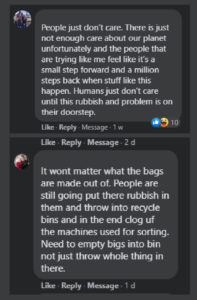
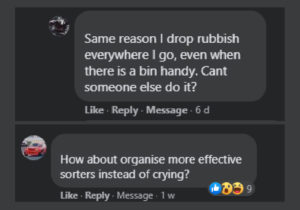
But apathy wasn’t the only issue, well-meaning but confused recyclers were still hesitating at the bin, and called for harmonised recycling rules and clearer information about the recyclability of everyday items.
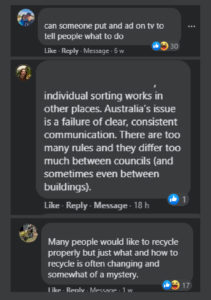
What’s the solution?
Source separated recycling systems
Source separation involves separating waste into common material streams or categories for separate collection. The idea is that a standalone bin for each material (food, dry commingled recycling, general waste) reduces contamination and encourages a clean, high quality input of materials to recyclers.
This calls for national bin standards that put the responsibility on generators of waste to separate materials at the point of disposal. It’s also critical to empower communities with resources to help them understand exactly what goes in each bin such as our Recycling Hub.
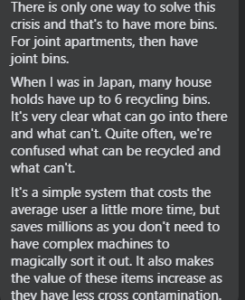
Working with the waste hierarchy to reduce, reuse and recycle
It was encouraging to see so many people engaged with the waste minimisation message with some calling for complete bans on throwaway plastic items where it hasn’t been already implemented, and increased use of compostable material in packaging.
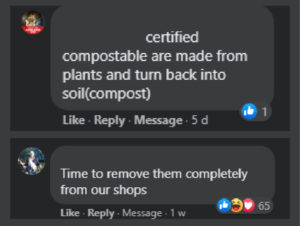
Greater ownership by generators of waste
Product stewardship programs put the responsibility for minimising a product’s environmental impact throughout all stages of the products’ life cycle, including end of life management, on whoever designs, manufactures, sells, or uses it. This echoes our views on what’s required to fix Australia’s recycling system and become a world leader in creating a circular economy.
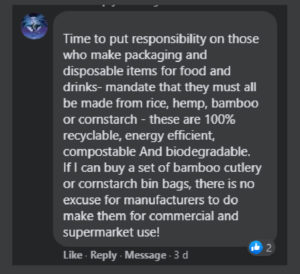
Innovative technologies to recover energy from waste
Energy-from-waste came up in conversations, pointing to successful projects in Europe that turn red bin waste that cannot be otherwise recovered into electricity to power homes and businesses.
Interested to know more about energy-from-waste technology in Australia?
Energy-from-waste: a piece of the waste management puzzle
Learn about energy-from-waste technology, why it’s necessary and how it can be done safely and sustainably
Energy-from-waste: Concerns and facts
Learn about the common misconceptions surrounding energy-from-waste technology including concerns around safety, regulations, emissions and recycling.
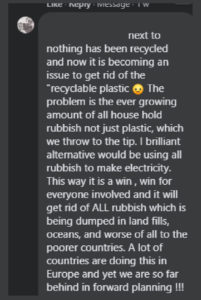
The bottom line
Communities should focus on getting recycling right through basic recycling hygiene such as knowing which materials belong in the commingled bin. Governments should continue to provide the framework for effective recycling systems through funding and policy support. Industry needs to provide infrastructure and services that enable resource recovery every step of the way.
What would you do to encourage better recycling? Join the conversation on our Facebook post here.
Contact us to learn more about how we’re making a sustainable future possible in the communities where we operate.